HRES1101: Change Implementation Plan for Bow Valley Manufacturing
VerifiedAdded on 2023/04/08
|10
|1445
|369
Presentation
AI Summary
This assignment provides a change strategy and implementation plan for Bow Valley Manufacturing following its acquisition of Elbow River Manufacturing, utilizing Kotter's 8-step change model. The solution includes creating a sense of urgency, building a guiding coalition, forming a strategic vision, enlisting a volunteer army, enabling action by removing barriers, generating short-term wins, sustaining acceleration, and instituting change. The presentation transcript bullet points elaborate on each step, providing actionable measures and examples such as Walmart's response to Amazon and Aetna's coalition-building strategy. The assignment emphasizes the importance of communication, employee involvement, and continuous improvement in ensuring successful organizational change.

Running head: MANAGEMENT
Organizational Behavior
Name of the Student:
Name of the University:
Author Note:
Organizational Behavior
Name of the Student:
Name of the University:
Author Note:
Paraphrase This Document
Need a fresh take? Get an instant paraphrase of this document with our AI Paraphraser
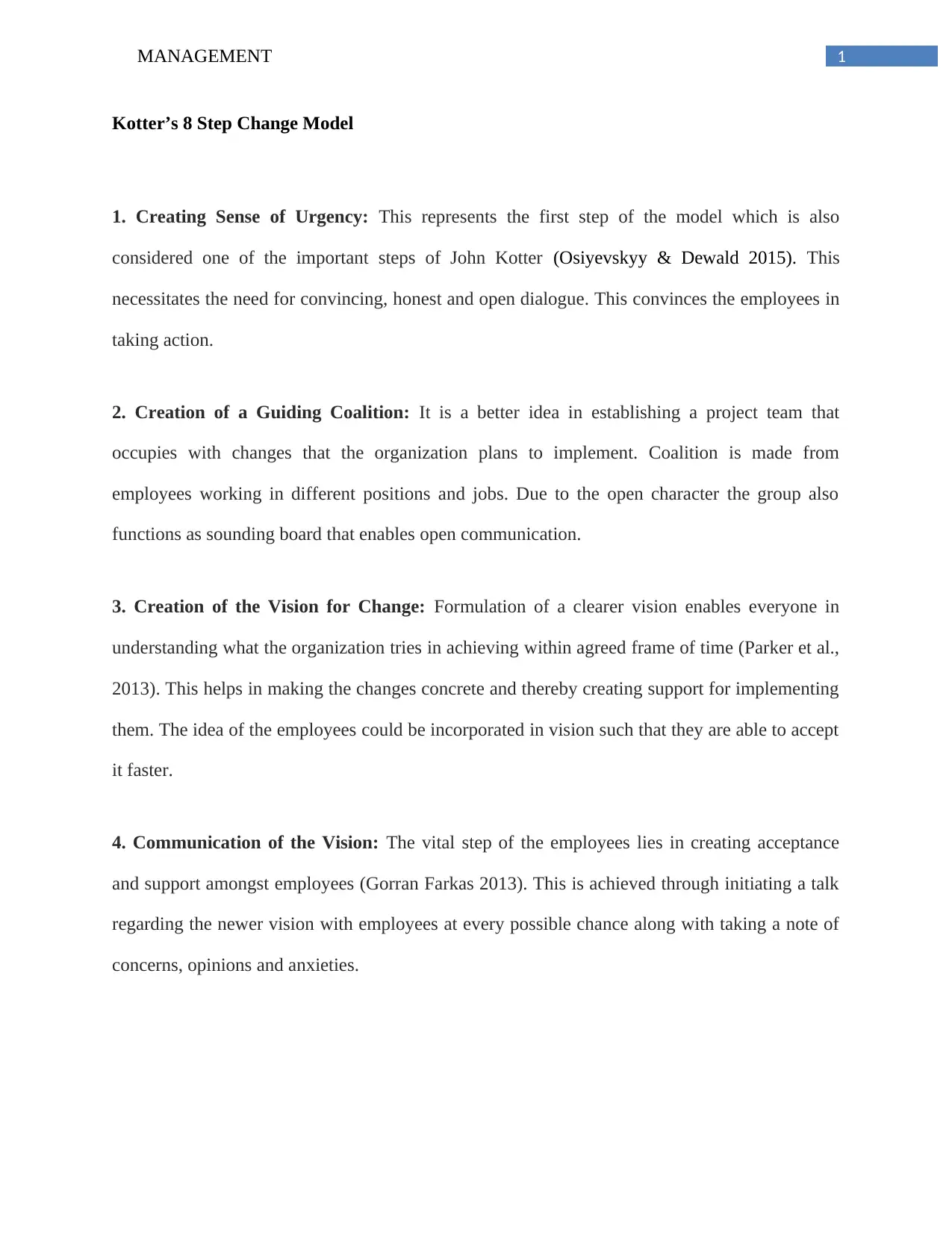
1MANAGEMENT
Kotter’s 8 Step Change Model
1. Creating Sense of Urgency: This represents the first step of the model which is also
considered one of the important steps of John Kotter (Osiyevskyy & Dewald 2015). This
necessitates the need for convincing, honest and open dialogue. This convinces the employees in
taking action.
2. Creation of a Guiding Coalition: It is a better idea in establishing a project team that
occupies with changes that the organization plans to implement. Coalition is made from
employees working in different positions and jobs. Due to the open character the group also
functions as sounding board that enables open communication.
3. Creation of the Vision for Change: Formulation of a clearer vision enables everyone in
understanding what the organization tries in achieving within agreed frame of time (Parker et al.,
2013). This helps in making the changes concrete and thereby creating support for implementing
them. The idea of the employees could be incorporated in vision such that they are able to accept
it faster.
4. Communication of the Vision: The vital step of the employees lies in creating acceptance
and support amongst employees (Gorran Farkas 2013). This is achieved through initiating a talk
regarding the newer vision with employees at every possible chance along with taking a note of
concerns, opinions and anxieties.
Kotter’s 8 Step Change Model
1. Creating Sense of Urgency: This represents the first step of the model which is also
considered one of the important steps of John Kotter (Osiyevskyy & Dewald 2015). This
necessitates the need for convincing, honest and open dialogue. This convinces the employees in
taking action.
2. Creation of a Guiding Coalition: It is a better idea in establishing a project team that
occupies with changes that the organization plans to implement. Coalition is made from
employees working in different positions and jobs. Due to the open character the group also
functions as sounding board that enables open communication.
3. Creation of the Vision for Change: Formulation of a clearer vision enables everyone in
understanding what the organization tries in achieving within agreed frame of time (Parker et al.,
2013). This helps in making the changes concrete and thereby creating support for implementing
them. The idea of the employees could be incorporated in vision such that they are able to accept
it faster.
4. Communication of the Vision: The vital step of the employees lies in creating acceptance
and support amongst employees (Gorran Farkas 2013). This is achieved through initiating a talk
regarding the newer vision with employees at every possible chance along with taking a note of
concerns, opinions and anxieties.
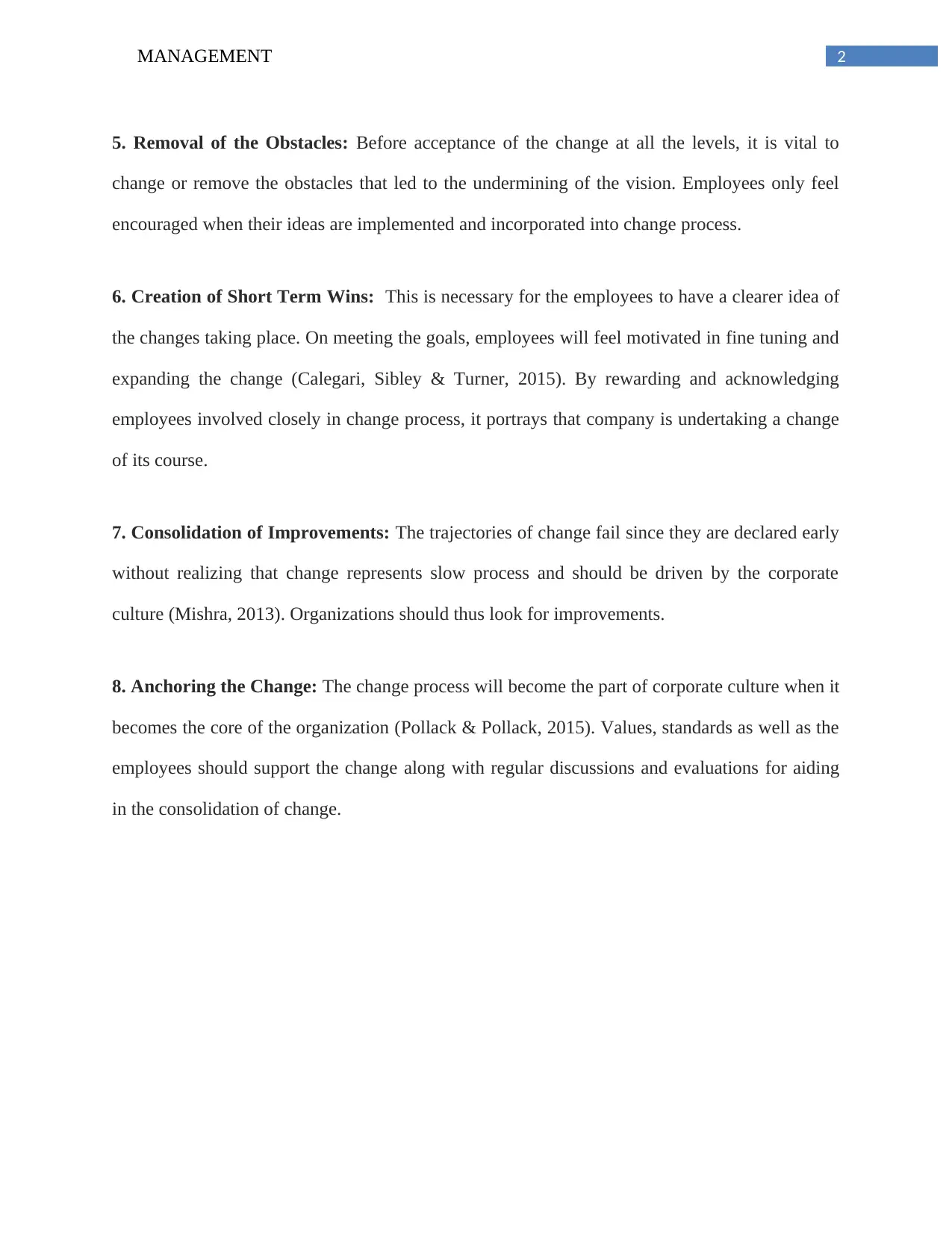
2MANAGEMENT
5. Removal of the Obstacles: Before acceptance of the change at all the levels, it is vital to
change or remove the obstacles that led to the undermining of the vision. Employees only feel
encouraged when their ideas are implemented and incorporated into change process.
6. Creation of Short Term Wins: This is necessary for the employees to have a clearer idea of
the changes taking place. On meeting the goals, employees will feel motivated in fine tuning and
expanding the change (Calegari, Sibley & Turner, 2015). By rewarding and acknowledging
employees involved closely in change process, it portrays that company is undertaking a change
of its course.
7. Consolidation of Improvements: The trajectories of change fail since they are declared early
without realizing that change represents slow process and should be driven by the corporate
culture (Mishra, 2013). Organizations should thus look for improvements.
8. Anchoring the Change: The change process will become the part of corporate culture when it
becomes the core of the organization (Pollack & Pollack, 2015). Values, standards as well as the
employees should support the change along with regular discussions and evaluations for aiding
in the consolidation of change.
5. Removal of the Obstacles: Before acceptance of the change at all the levels, it is vital to
change or remove the obstacles that led to the undermining of the vision. Employees only feel
encouraged when their ideas are implemented and incorporated into change process.
6. Creation of Short Term Wins: This is necessary for the employees to have a clearer idea of
the changes taking place. On meeting the goals, employees will feel motivated in fine tuning and
expanding the change (Calegari, Sibley & Turner, 2015). By rewarding and acknowledging
employees involved closely in change process, it portrays that company is undertaking a change
of its course.
7. Consolidation of Improvements: The trajectories of change fail since they are declared early
without realizing that change represents slow process and should be driven by the corporate
culture (Mishra, 2013). Organizations should thus look for improvements.
8. Anchoring the Change: The change process will become the part of corporate culture when it
becomes the core of the organization (Pollack & Pollack, 2015). Values, standards as well as the
employees should support the change along with regular discussions and evaluations for aiding
in the consolidation of change.
⊘ This is a preview!⊘
Do you want full access?
Subscribe today to unlock all pages.

Trusted by 1+ million students worldwide
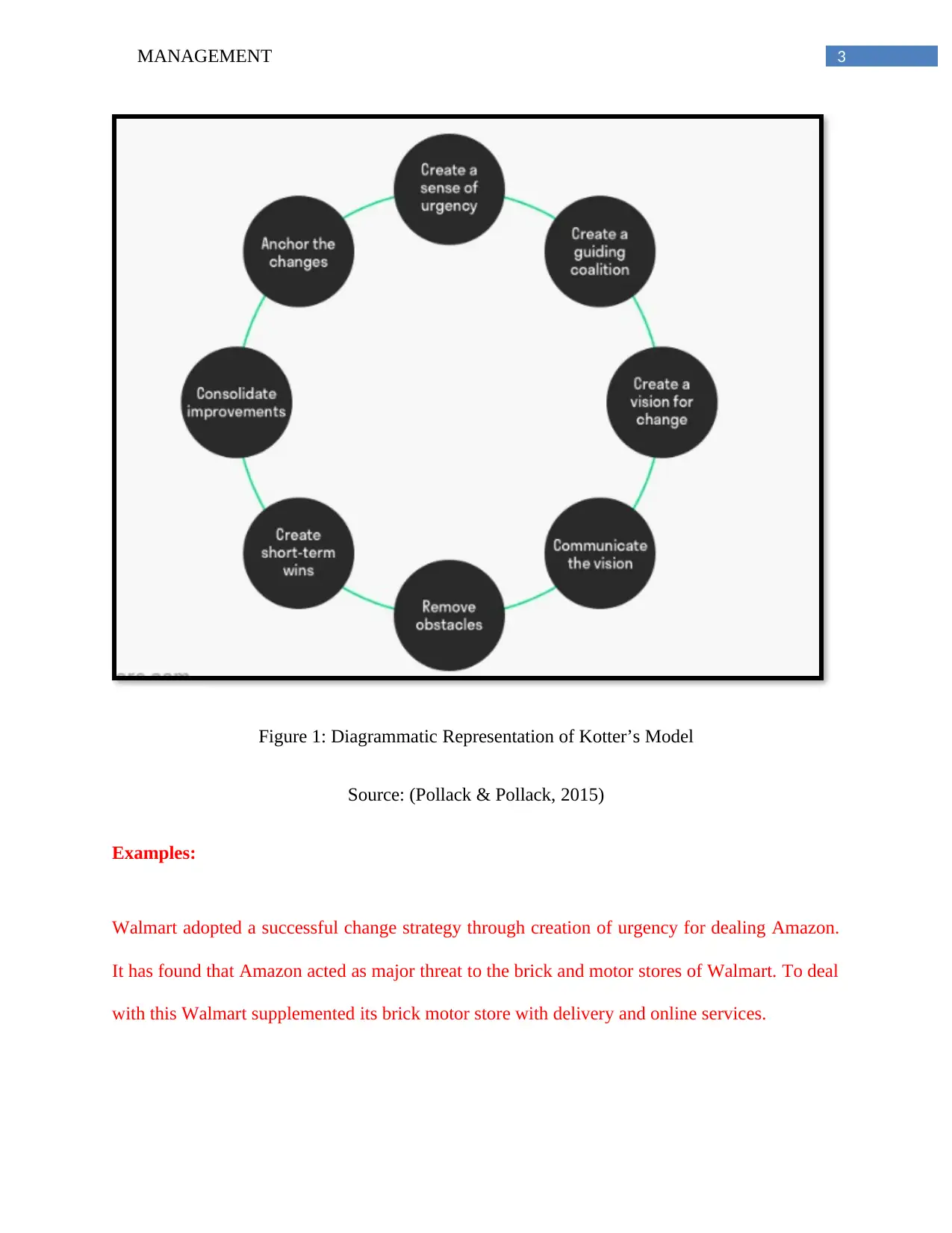
3MANAGEMENT
Figure 1: Diagrammatic Representation of Kotter’s Model
Source: (Pollack & Pollack, 2015)
Examples:
Walmart adopted a successful change strategy through creation of urgency for dealing Amazon.
It has found that Amazon acted as major threat to the brick and motor stores of Walmart. To deal
with this Walmart supplemented its brick motor store with delivery and online services.
Figure 1: Diagrammatic Representation of Kotter’s Model
Source: (Pollack & Pollack, 2015)
Examples:
Walmart adopted a successful change strategy through creation of urgency for dealing Amazon.
It has found that Amazon acted as major threat to the brick and motor stores of Walmart. To deal
with this Walmart supplemented its brick motor store with delivery and online services.
Paraphrase This Document
Need a fresh take? Get an instant paraphrase of this document with our AI Paraphraser

4MANAGEMENT
Aetna is an example of an American healthcare organization that initiated a successful change
strategy through galvanizing coalition.
Aetna is an example of an American healthcare organization that initiated a successful change
strategy through galvanizing coalition.
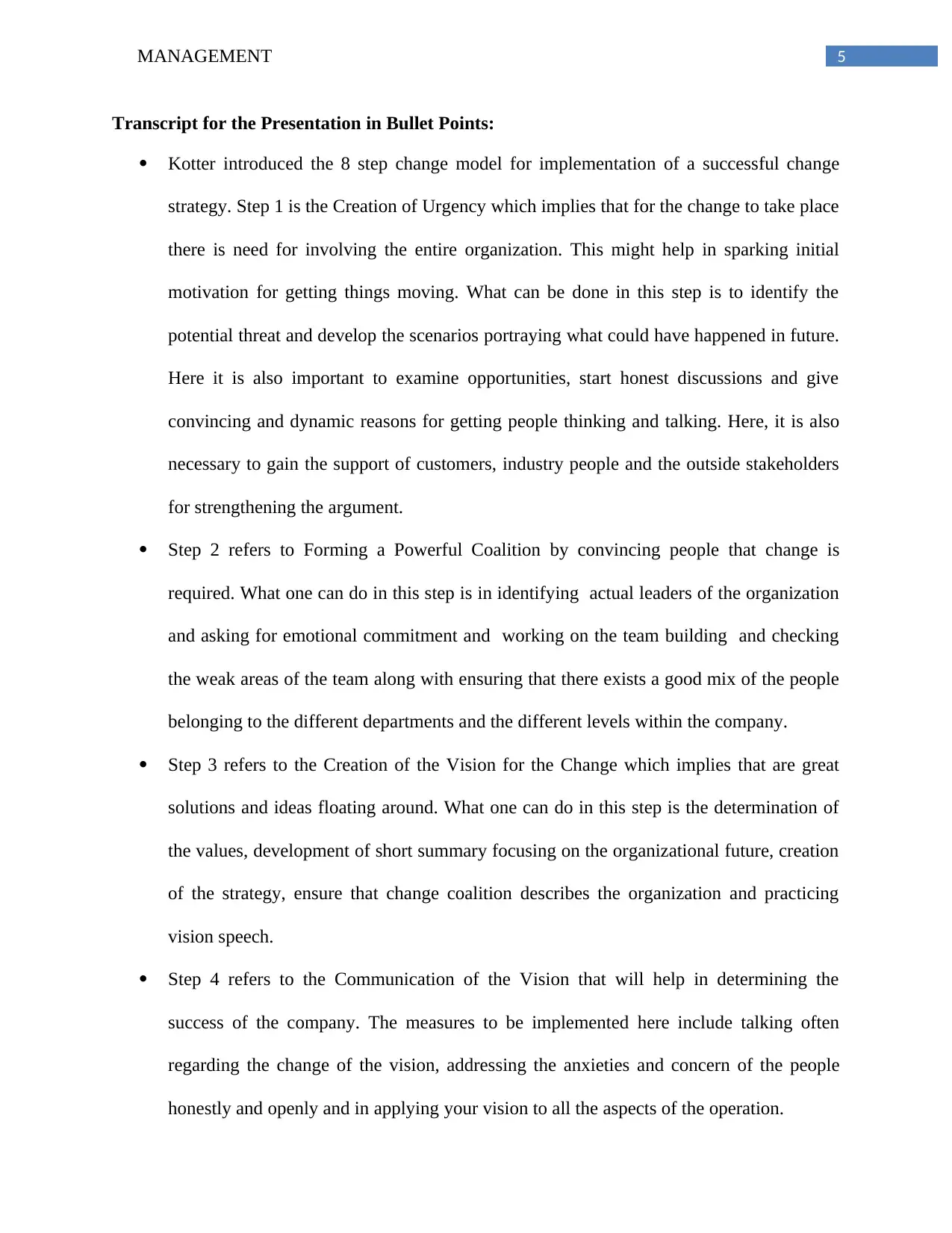
5MANAGEMENT
Transcript for the Presentation in Bullet Points:
Kotter introduced the 8 step change model for implementation of a successful change
strategy. Step 1 is the Creation of Urgency which implies that for the change to take place
there is need for involving the entire organization. This might help in sparking initial
motivation for getting things moving. What can be done in this step is to identify the
potential threat and develop the scenarios portraying what could have happened in future.
Here it is also important to examine opportunities, start honest discussions and give
convincing and dynamic reasons for getting people thinking and talking. Here, it is also
necessary to gain the support of customers, industry people and the outside stakeholders
for strengthening the argument.
Step 2 refers to Forming a Powerful Coalition by convincing people that change is
required. What one can do in this step is in identifying actual leaders of the organization
and asking for emotional commitment and working on the team building and checking
the weak areas of the team along with ensuring that there exists a good mix of the people
belonging to the different departments and the different levels within the company.
Step 3 refers to the Creation of the Vision for the Change which implies that are great
solutions and ideas floating around. What one can do in this step is the determination of
the values, development of short summary focusing on the organizational future, creation
of the strategy, ensure that change coalition describes the organization and practicing
vision speech.
Step 4 refers to the Communication of the Vision that will help in determining the
success of the company. The measures to be implemented here include talking often
regarding the change of the vision, addressing the anxieties and concern of the people
honestly and openly and in applying your vision to all the aspects of the operation.
Transcript for the Presentation in Bullet Points:
Kotter introduced the 8 step change model for implementation of a successful change
strategy. Step 1 is the Creation of Urgency which implies that for the change to take place
there is need for involving the entire organization. This might help in sparking initial
motivation for getting things moving. What can be done in this step is to identify the
potential threat and develop the scenarios portraying what could have happened in future.
Here it is also important to examine opportunities, start honest discussions and give
convincing and dynamic reasons for getting people thinking and talking. Here, it is also
necessary to gain the support of customers, industry people and the outside stakeholders
for strengthening the argument.
Step 2 refers to Forming a Powerful Coalition by convincing people that change is
required. What one can do in this step is in identifying actual leaders of the organization
and asking for emotional commitment and working on the team building and checking
the weak areas of the team along with ensuring that there exists a good mix of the people
belonging to the different departments and the different levels within the company.
Step 3 refers to the Creation of the Vision for the Change which implies that are great
solutions and ideas floating around. What one can do in this step is the determination of
the values, development of short summary focusing on the organizational future, creation
of the strategy, ensure that change coalition describes the organization and practicing
vision speech.
Step 4 refers to the Communication of the Vision that will help in determining the
success of the company. The measures to be implemented here include talking often
regarding the change of the vision, addressing the anxieties and concern of the people
honestly and openly and in applying your vision to all the aspects of the operation.
⊘ This is a preview!⊘
Do you want full access?
Subscribe today to unlock all pages.

Trusted by 1+ million students worldwide
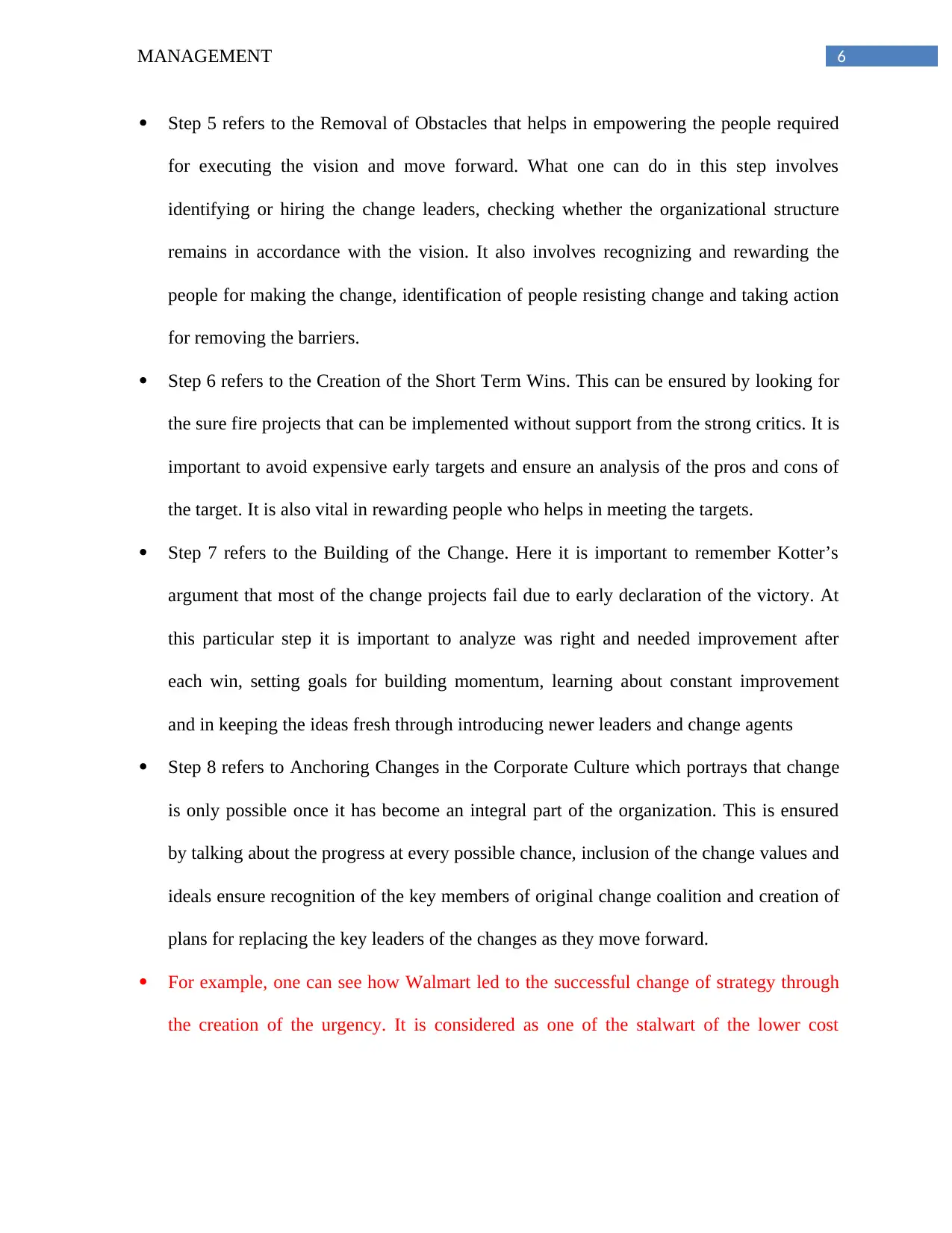
6MANAGEMENT
Step 5 refers to the Removal of Obstacles that helps in empowering the people required
for executing the vision and move forward. What one can do in this step involves
identifying or hiring the change leaders, checking whether the organizational structure
remains in accordance with the vision. It also involves recognizing and rewarding the
people for making the change, identification of people resisting change and taking action
for removing the barriers.
Step 6 refers to the Creation of the Short Term Wins. This can be ensured by looking for
the sure fire projects that can be implemented without support from the strong critics. It is
important to avoid expensive early targets and ensure an analysis of the pros and cons of
the target. It is also vital in rewarding people who helps in meeting the targets.
Step 7 refers to the Building of the Change. Here it is important to remember Kotter’s
argument that most of the change projects fail due to early declaration of the victory. At
this particular step it is important to analyze was right and needed improvement after
each win, setting goals for building momentum, learning about constant improvement
and in keeping the ideas fresh through introducing newer leaders and change agents
Step 8 refers to Anchoring Changes in the Corporate Culture which portrays that change
is only possible once it has become an integral part of the organization. This is ensured
by talking about the progress at every possible chance, inclusion of the change values and
ideals ensure recognition of the key members of original change coalition and creation of
plans for replacing the key leaders of the changes as they move forward.
For example, one can see how Walmart led to the successful change of strategy through
the creation of the urgency. It is considered as one of the stalwart of the lower cost
Step 5 refers to the Removal of Obstacles that helps in empowering the people required
for executing the vision and move forward. What one can do in this step involves
identifying or hiring the change leaders, checking whether the organizational structure
remains in accordance with the vision. It also involves recognizing and rewarding the
people for making the change, identification of people resisting change and taking action
for removing the barriers.
Step 6 refers to the Creation of the Short Term Wins. This can be ensured by looking for
the sure fire projects that can be implemented without support from the strong critics. It is
important to avoid expensive early targets and ensure an analysis of the pros and cons of
the target. It is also vital in rewarding people who helps in meeting the targets.
Step 7 refers to the Building of the Change. Here it is important to remember Kotter’s
argument that most of the change projects fail due to early declaration of the victory. At
this particular step it is important to analyze was right and needed improvement after
each win, setting goals for building momentum, learning about constant improvement
and in keeping the ideas fresh through introducing newer leaders and change agents
Step 8 refers to Anchoring Changes in the Corporate Culture which portrays that change
is only possible once it has become an integral part of the organization. This is ensured
by talking about the progress at every possible chance, inclusion of the change values and
ideals ensure recognition of the key members of original change coalition and creation of
plans for replacing the key leaders of the changes as they move forward.
For example, one can see how Walmart led to the successful change of strategy through
the creation of the urgency. It is considered as one of the stalwart of the lower cost
Paraphrase This Document
Need a fresh take? Get an instant paraphrase of this document with our AI Paraphraser
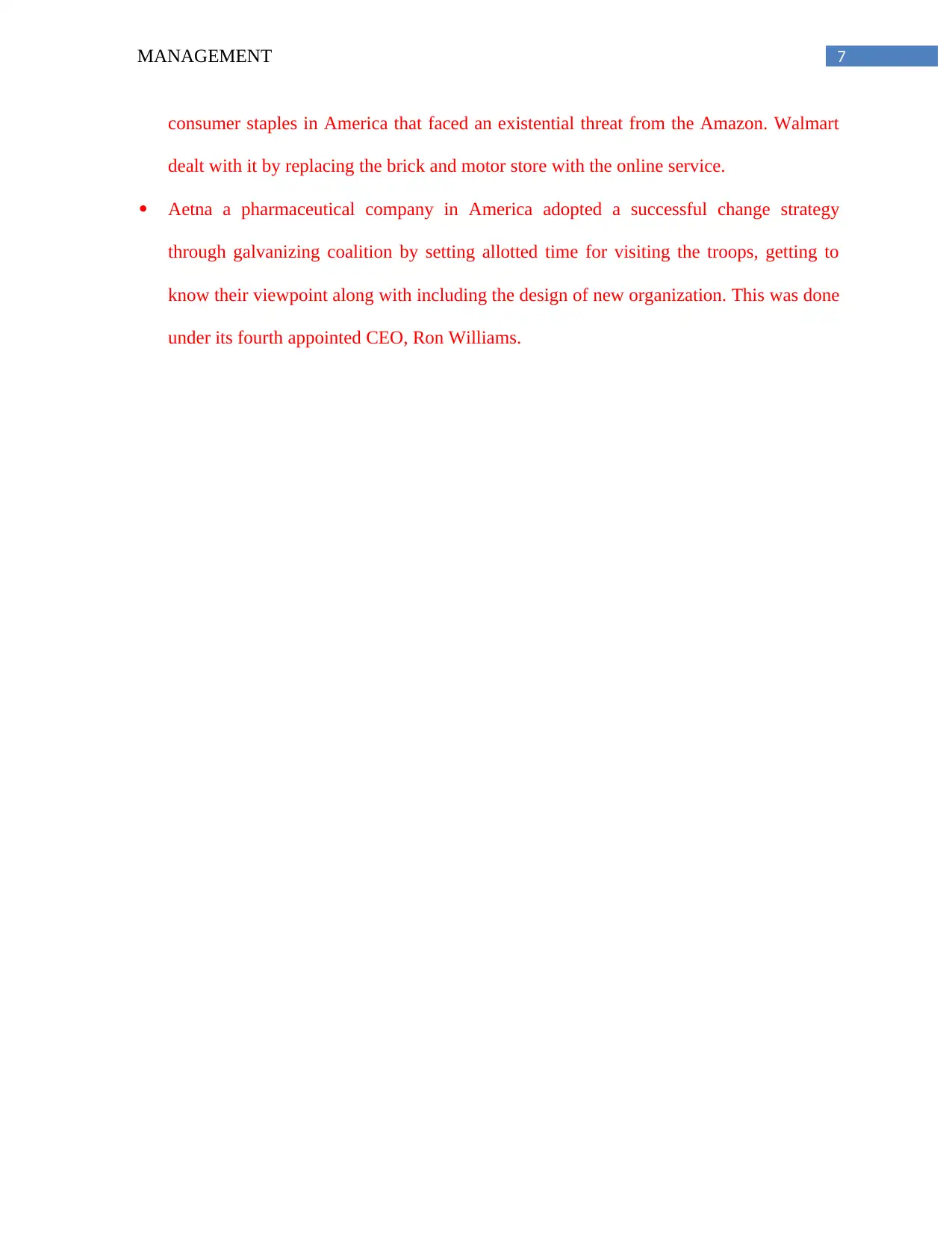
7MANAGEMENT
consumer staples in America that faced an existential threat from the Amazon. Walmart
dealt with it by replacing the brick and motor store with the online service.
Aetna a pharmaceutical company in America adopted a successful change strategy
through galvanizing coalition by setting allotted time for visiting the troops, getting to
know their viewpoint along with including the design of new organization. This was done
under its fourth appointed CEO, Ron Williams.
consumer staples in America that faced an existential threat from the Amazon. Walmart
dealt with it by replacing the brick and motor store with the online service.
Aetna a pharmaceutical company in America adopted a successful change strategy
through galvanizing coalition by setting allotted time for visiting the troops, getting to
know their viewpoint along with including the design of new organization. This was done
under its fourth appointed CEO, Ron Williams.
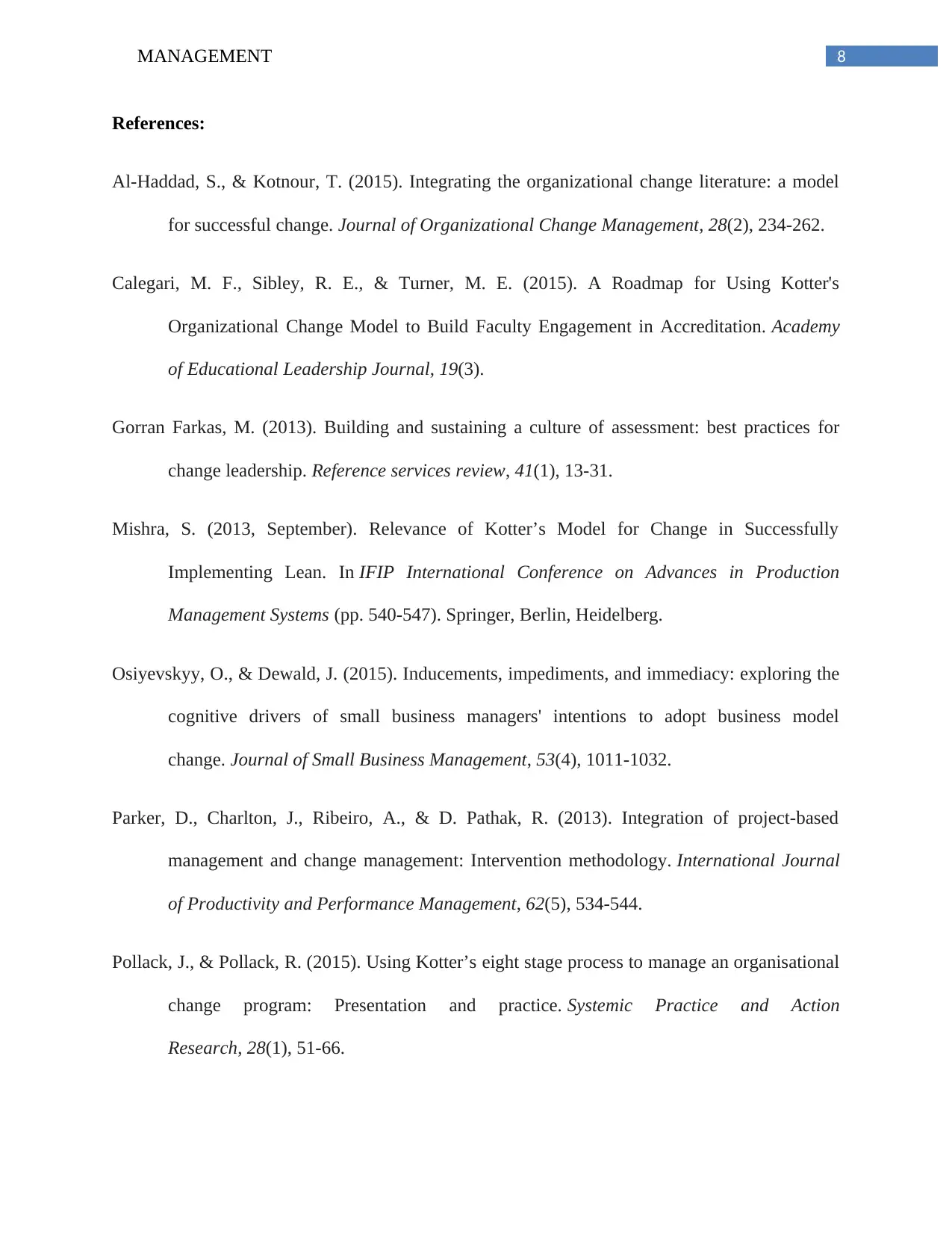
8MANAGEMENT
References:
Al-Haddad, S., & Kotnour, T. (2015). Integrating the organizational change literature: a model
for successful change. Journal of Organizational Change Management, 28(2), 234-262.
Calegari, M. F., Sibley, R. E., & Turner, M. E. (2015). A Roadmap for Using Kotter's
Organizational Change Model to Build Faculty Engagement in Accreditation. Academy
of Educational Leadership Journal, 19(3).
Gorran Farkas, M. (2013). Building and sustaining a culture of assessment: best practices for
change leadership. Reference services review, 41(1), 13-31.
Mishra, S. (2013, September). Relevance of Kotter’s Model for Change in Successfully
Implementing Lean. In IFIP International Conference on Advances in Production
Management Systems (pp. 540-547). Springer, Berlin, Heidelberg.
Osiyevskyy, O., & Dewald, J. (2015). Inducements, impediments, and immediacy: exploring the
cognitive drivers of small business managers' intentions to adopt business model
change. Journal of Small Business Management, 53(4), 1011-1032.
Parker, D., Charlton, J., Ribeiro, A., & D. Pathak, R. (2013). Integration of project-based
management and change management: Intervention methodology. International Journal
of Productivity and Performance Management, 62(5), 534-544.
Pollack, J., & Pollack, R. (2015). Using Kotter’s eight stage process to manage an organisational
change program: Presentation and practice. Systemic Practice and Action
Research, 28(1), 51-66.
References:
Al-Haddad, S., & Kotnour, T. (2015). Integrating the organizational change literature: a model
for successful change. Journal of Organizational Change Management, 28(2), 234-262.
Calegari, M. F., Sibley, R. E., & Turner, M. E. (2015). A Roadmap for Using Kotter's
Organizational Change Model to Build Faculty Engagement in Accreditation. Academy
of Educational Leadership Journal, 19(3).
Gorran Farkas, M. (2013). Building and sustaining a culture of assessment: best practices for
change leadership. Reference services review, 41(1), 13-31.
Mishra, S. (2013, September). Relevance of Kotter’s Model for Change in Successfully
Implementing Lean. In IFIP International Conference on Advances in Production
Management Systems (pp. 540-547). Springer, Berlin, Heidelberg.
Osiyevskyy, O., & Dewald, J. (2015). Inducements, impediments, and immediacy: exploring the
cognitive drivers of small business managers' intentions to adopt business model
change. Journal of Small Business Management, 53(4), 1011-1032.
Parker, D., Charlton, J., Ribeiro, A., & D. Pathak, R. (2013). Integration of project-based
management and change management: Intervention methodology. International Journal
of Productivity and Performance Management, 62(5), 534-544.
Pollack, J., & Pollack, R. (2015). Using Kotter’s eight stage process to manage an organisational
change program: Presentation and practice. Systemic Practice and Action
Research, 28(1), 51-66.
⊘ This is a preview!⊘
Do you want full access?
Subscribe today to unlock all pages.

Trusted by 1+ million students worldwide

9MANAGEMENT
Pollack, J., & Pollack, R. (2015). Using Kotter’s eight stage process to manage an organisational
change program: Presentation and practice. Systemic Practice and Action
Research, 28(1), 51-66.
Pollack, J., & Pollack, R. (2015). Using Kotter’s eight stage process to manage an organisational
change program: Presentation and practice. Systemic Practice and Action
Research, 28(1), 51-66.
1 out of 10
Related Documents
Your All-in-One AI-Powered Toolkit for Academic Success.
+13062052269
info@desklib.com
Available 24*7 on WhatsApp / Email
![[object Object]](/_next/static/media/star-bottom.7253800d.svg)
Unlock your academic potential
Copyright © 2020–2025 A2Z Services. All Rights Reserved. Developed and managed by ZUCOL.





